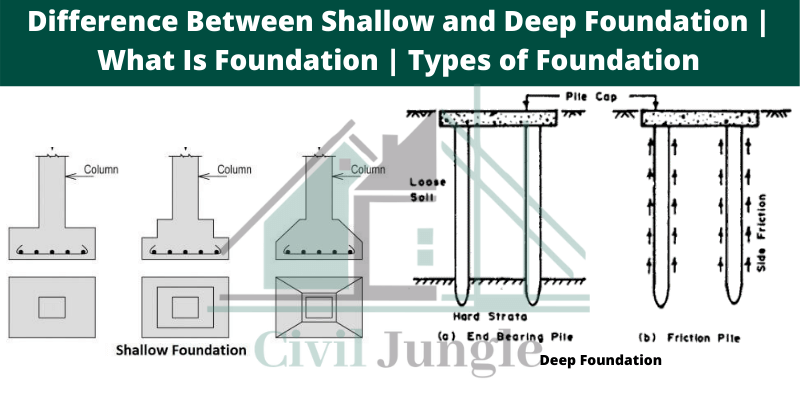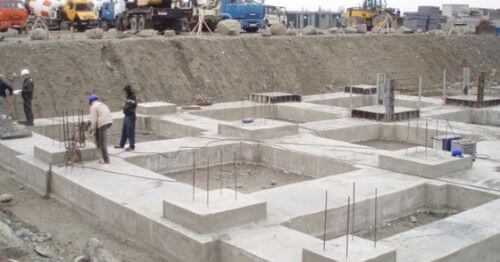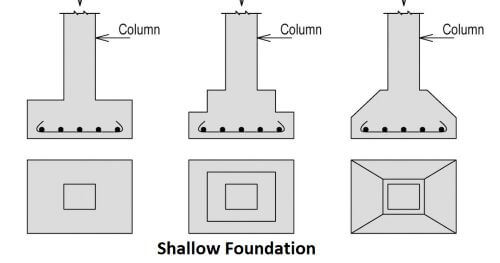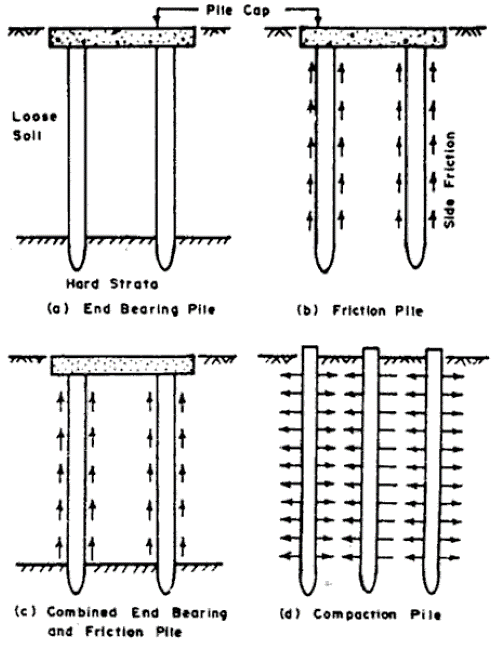What Is Foundation?
Important Point
A foundation is the element of a structure which connects it to the ground and transfers loads from the structure to the ground.
Foundation engineering is the application of soil mechanics and rock mechanics (Geotechnical engineering) in the design of foundation elements of structures.
Types of Foundation
Following are different types of Foundations used in construction:
Shallow Foundation
Following are different types of Shallow Foundations used in construction:
- Individual Footing
- Combined Footing
- Strip Foundation
- Raft or Mat Foundation
- Spread Footing Foundations,
- Slab-On-Grade Foundations,
- Pad Foundations,
- Rubble Trench Foundations
- Earthbag Foundations
Also, read: What Is Fresh Concrete | Properties of Fresh Concrete
Deep Foundation
Following are different types of Deep Foundations used in construction:
- Pile Foundations
- Caissons Foundations
- Cylinders Foundations
- Basements Foundations
- Hollow Box Foundations (Buoyancy Rafts)
- Shaft Foundations
Shallow Foundation Definition
A shallow foundation is a type of building a foundation that transfers building loads to the earth very near to the surface, rather than to a subsurface layer or a range of depths as does a deep foundation.
Shallow foundations include spread footing foundations, mat-slab foundations, slab-on-grade foundations, pad foundations, rubble trench foundations and earthbag foundations.
Shallow foundations are constructed where soil layer at shallow depth is able to support the structural loads. The depth of shallow foundation is generally less than its width.
It can be used where the bearing capacity of soil on which the structure is to be constructed is maximum then Shallow Foundation can be used. Minimum depth of this Foundation is 800mm and maximum depth not to be taken more than 4 meters.
Deep Foundation Definition
A deep foundation is a type of foundation that transfers building loads to the earth farther down from the surface than a shallow foundation does to a subsurface layer or a range of depths.
A deep foundation is required to carry loads from a structure through weak compressible soils or fills on to stronger and less compressible soils or rocks at depth, or for functional reasons.
Deep foundations are founded too deeply below the finished ground surface for their base bearing capacity to be affected by surface conditions, this is usually at depths >3 m below finished ground level.
How Deep Are Foundations?
The words shallow and deep refer to the depth of soil in which the foundation is made. Shallow foundations can be made in depths of as little as 3ft (1m), while deep foundations can be made at depths of 60 – 200ft (20 – 65m).
Difference Between Shallow and Deep Foundation
| Sr. No. | Detail | Shallow Foundation | Deep Foundation |
| 1 | Meaning | Shallow means having little depth. | Deep means extending far away from a point of reference, especially downwards. Extending far down from the top or surface |
| 2 | Definition | Foundation which is placed near the surface of the earth or transfers the loads at shallow depth is called the shallow foundation. | Foundation which is placed at a greater depth or transfers the loads to deep strata is called the deep foundation. |
| 3 | Cost | A shallow foundation is cheaper. | Deep foundations are generally more expensive than shallow foundations. |
| 4 | Types of Foundations | Shallow foundations include strip footing, isolated footings, combined footings, mat foundations, and grade beams. | Deep foundations include pile caps, piles, drilled piers, and caissons. |
| 5 | Depth of the Foundation | Shallow foundations can be made in depths of as little as 3ft (1m) | Deep foundations can be made at depths of 60 – 200ft (20 – 65m). |
| 6 | Shape of Footing | A shallow foundation is a rectangular or square shape. | A deep foundation is a bit circular and cylindrical shape. |
| 7 | Feasibility | Shallow foundations are easier to construct. | A deep foundation is more complex. |
| 8 | Mechanism of Load Transfer | Shallow foundations transfer loads mostly by end bearing. | Deep foundations rely both on end bearing and skin friction, with few exceptions like end-bearing pile. |
| 9 | Advantages | Construction materials are available, less labour is needed, construction procedure is simple at an affordable cost, etc. | Deep foundation can be provided at a greater depth, Provide lateral support and resist uplift, effective when foundation at shallow depth is not possible, can carry a huge load, etc. |
| 10 | Disadvantages | Possibility of a settlement, usually applicable for lightweight structure, weak against lateral loads, etc. | More expensive needs skilled labours, complex construction procedures, can be time-consuming and some types of deep foundations are not very flexible, etc. |
Shallow Foundation Depth
A shallow foundation can be constructed in as little as a one-foot depth, whereas a deep foundations is formed at a depth of 10-300 feet. As such, a shallow foundation is used for projects that are small or lighter-weight buildings, and deep foundations for larger or hillside developments, or those on poor soil.
Types of Deep Foundations
There are different terms used to describe different types of deep foundations including the pile (which is analogous to a pole), the pier (which is analogous to a column), drilled shafts, and caissons.
Like this post? Share it with your friends!
Suggested Read –
- Pile Caps Foundation
- Top 20 AAC Block Company in India
- Difference Between CPM and PERT | What Is CPM & PERT
- What Is Gypsum Plaster | Advantage and Disadvantage of Gypsum Plaster
- Difference Between Veneer and Laminate | What Is Veneer | What Is Laminate
- Difference Between Compaction and Consolidation | What Is Compaction | What Is Consolidation
- BHK Full From | What Is BHK | What does 1BHK, 2BHK, 3BHK, 4 BHK, 2.5 BHK, 1 RK, 2 BHK 2T, 3 BHK 2T, 3 BHK 3T Mean
Originally posted 2022-04-08 00:33:24.





Good information Sir/Mdam,
Thank you.